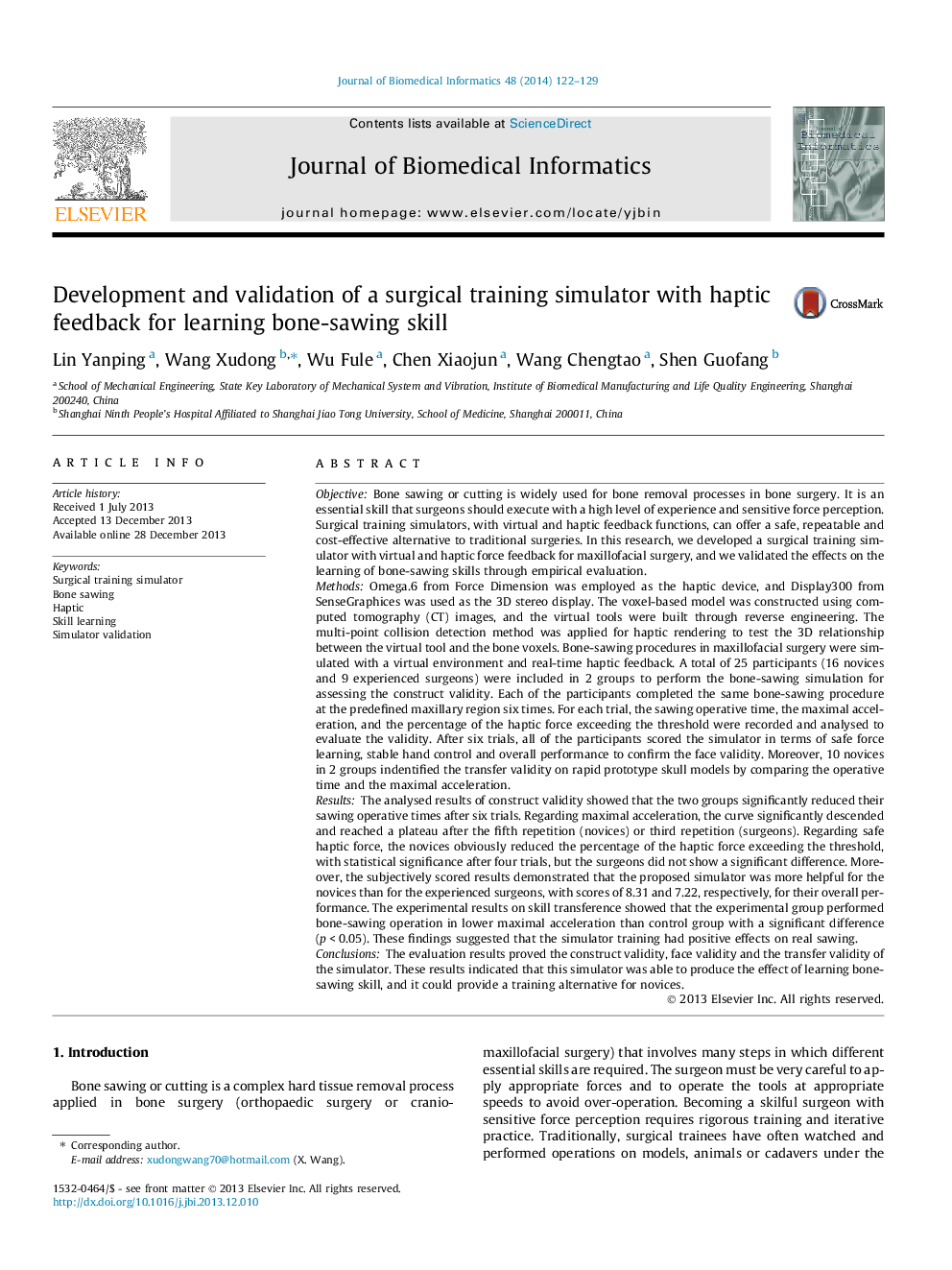| کد مقاله | کد نشریه | سال انتشار | مقاله انگلیسی | نسخه تمام متن |
|---|---|---|---|---|
| 517120 | 867417 | 2014 | 8 صفحه PDF | دانلود رایگان |
• We developed a visuo-haptic surgical training simulator for bone-sawing procedure.
• We validated the simulator’s face validity and construct validity.
• This simulator was able to produce the effect of learning bone-sawing skill.
• This simulator could provide a training alternative for novices.
ObjectiveBone sawing or cutting is widely used for bone removal processes in bone surgery. It is an essential skill that surgeons should execute with a high level of experience and sensitive force perception. Surgical training simulators, with virtual and haptic feedback functions, can offer a safe, repeatable and cost-effective alternative to traditional surgeries. In this research, we developed a surgical training simulator with virtual and haptic force feedback for maxillofacial surgery, and we validated the effects on the learning of bone-sawing skills through empirical evaluation.MethodsOmega.6 from Force Dimension was employed as the haptic device, and Display300 from SenseGraphices was used as the 3D stereo display. The voxel-based model was constructed using computed tomography (CT) images, and the virtual tools were built through reverse engineering. The multi-point collision detection method was applied for haptic rendering to test the 3D relationship between the virtual tool and the bone voxels. Bone-sawing procedures in maxillofacial surgery were simulated with a virtual environment and real-time haptic feedback. A total of 25 participants (16 novices and 9 experienced surgeons) were included in 2 groups to perform the bone-sawing simulation for assessing the construct validity. Each of the participants completed the same bone-sawing procedure at the predefined maxillary region six times. For each trial, the sawing operative time, the maximal acceleration, and the percentage of the haptic force exceeding the threshold were recorded and analysed to evaluate the validity. After six trials, all of the participants scored the simulator in terms of safe force learning, stable hand control and overall performance to confirm the face validity. Moreover, 10 novices in 2 groups indentified the transfer validity on rapid prototype skull models by comparing the operative time and the maximal acceleration.ResultsThe analysed results of construct validity showed that the two groups significantly reduced their sawing operative times after six trials. Regarding maximal acceleration, the curve significantly descended and reached a plateau after the fifth repetition (novices) or third repetition (surgeons). Regarding safe haptic force, the novices obviously reduced the percentage of the haptic force exceeding the threshold, with statistical significance after four trials, but the surgeons did not show a significant difference. Moreover, the subjectively scored results demonstrated that the proposed simulator was more helpful for the novices than for the experienced surgeons, with scores of 8.31 and 7.22, respectively, for their overall performance. The experimental results on skill transference showed that the experimental group performed bone-sawing operation in lower maximal acceleration than control group with a significant difference (p < 0.05). These findings suggested that the simulator training had positive effects on real sawing.ConclusionsThe evaluation results proved the construct validity, face validity and the transfer validity of the simulator. These results indicated that this simulator was able to produce the effect of learning bone-sawing skill, and it could provide a training alternative for novices.
Figure optionsDownload high-quality image (158 K)Download as PowerPoint slide
Journal: Journal of Biomedical Informatics - Volume 48, April 2014, Pages 122–129
